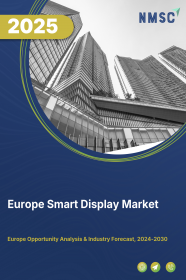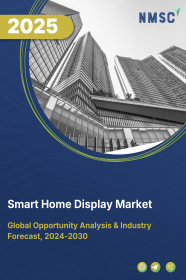
Europe Smart Display Market by Display Technology (LCD, LED, E-Paper Display, and Other Display Technologies), by Type (Standalone Smart Displays, Integrated Smart Displays, Interactive Touchscreen Displays, Transparent Smart Displays, and Other Display Types), by Display Size (Below 24 Inch, 24 Inch to 55 Inch, and Above 55 Inch), by Resolution (UHD, FHD, HD, and Others) and Others – Opportunity Analysis and Industry Forecast, 2023–2030
Industry: Semiconductor & Electronics | Publish Date: 15-Feb-2025 | No of Pages: 169 | No. of Tables: 136 | No. of Figures: 99 | Format: PDF | Report Code : SE1024
US Tariff Impact on Europe Smart Display Market
Trump Tariffs Are Reshaping Global Business
Market Definition
Europe Smart Display Market was valued at USD 3.74 billion in 2022, and is predicted to reach USD 10.33 billion by 2030, with a CAGR of 11.9% from 2023 to 2030. A smart display is a technologically advanced device equipped with a touchscreen or interactive visual interface, integrated with voice recognition and artificial intelligence capabilities.
These displays serve as information hubs that can perform a variety of functions, including displaying information, controlling smart home devices. It provides visual responses to voice commands, enabling video calls, and serving as interactive tools for tasks such as scheduling, weather updates, and entertainment.
Smart displays are designed to enhance convenience, accessibility, and user interactivity in various contexts, such as homes, offices, and public spaces. These displays are utilized in various settings, including residential homes, offices, healthcare facilities, retail, education, and more.
Driving Innovation: Smart Displays Transforming Europe's Automotive Landscape
In the automotive sector, European automakers are at the forefront of innovation, incorporating advanced smart displays into vehicles to elevate user interfaces and ignite increased demand. These manufacturers actively contribute to market expansion by continually enhancing smart displays, making them not only smarter and more interactive but also energy-efficient.
A notable trend is the seamless integration of these displays into the expanding smart home ecosystem, illustrating a convergence of technology that enriches both the driving experience and the connected home environment. This forward-thinking approach positions Europe as a leader in shaping the future of automotive technology and smart living.
Innovative Horizons: Europe's Pioneering Role in Wearable Smart Displays and the Smart Home Revolution
In the realm of wearable smart displays, Europe has become a focal point for pioneering innovations, with companies unveiling cutting-edge smart glasses featuring live streaming capabilities. This trend underscores the region's commitment to staying at the forefront of technological advancements.
The increasing awareness among consumers about the advantages of smart home solutions serves as a significant catalyst, driving the demand for smart displays. As a result, these devices are becoming more widely accessible, reaching a diverse audience and further solidifying Europe's position as a leader in the integration of innovative smart technologies.
Security Vulnerabilities in Smart Home Displays Restrain Market Growth
Security vulnerabilities in smart display technology represent a significant restraining factor for the smart display market. The potential for security breaches in smart displays poses a substantial risk to users. Insufficient security measures, such as weak passwords and inadequate encryption, could lead to the exposure of sensitive data. Therefore, it is imperative for manufacturers to prioritize robust security features within smart displays, including strong authentication methods and prompt vulnerability patching through regular updates.
Introduction of Laser-based Display Technology
Laser-based display technology is presenting substantial opportunities within the smart display market. Its exceptional brightness, color accuracy, long-lasting durability, and energy efficiency position it as a prime choice for diverse applications, spanning from home theaters to outdoor signage and augmented reality experiences. The extended lifespan and reliability of laser-based displays result in reduced maintenance costs and align with sustainability objectives.
As this technology becomes increasingly accessible and cost-effective, it is instigating innovation in the realm of smart displays, particularly in sectors where top-tier visual quality and energy conservation are paramount, thus broadening the market's potential for expansion.
The Germany Holds the Dominant Market Share in the European Market
The growth of the smart display market is significantly propelled by the German automotive industry, represented by major players like Volkswagen, BMW, Daimler, and Audi. Renowned for incorporating advanced smart displays into their vehicles, these companies not only establish industry standards but also generate demand. Prioritizing innovative user interfaces to enrich the driving experience, they contribute to the widespread adoption of smart displays in vehicles, thereby fostering market growth.
For instance, in August 2023, BMW partnered with Samsung and developed the display technology for its subsidiary MINI's vehicles. The MINI Interaction Unit, a circular 9.4-inch OLED display, will be centrally positioned on the dashboard of MINI cars. This high-tech display essentially functions as an intelligent computer, running on the Android-based MINI 9 operating system. It offers features, including a GPS navigation system and a smart voice assistant that enables control over music playback, message sending, route adjustments, and more.
This partnership highlights the growing importance of advanced display technology in the automotive sector. BMW and Samsung's innovation is likely to set new standards, driving the adoption of smart displays in the broader automotive industry and, by extension, stimulating the growth of the smart display market.
Spain is Expected to Show Steady Growth in the European Smart Display Market
The increasing prevalence of smart and connected devices is intricately linked to Spain's smart display market. With substantial growth in the smart home sector in Spain, there is a clear indication of a growing acceptance of smart technologies within Spanish households.
This encompasses the adoption of smart displays, serving as central hubs for the management of diverse connected devices and services in smart homes. For instance, Spain is one of the frontrunners in smart home adoption with a rate of 39%, surpassing other countries in the region, while France follows closely behind at 31%.
Competitive Landscape
The Europe smart display industry includes several market players such as Samsung Electronics, Qisda Corporation (BenQ), LG Corporation, Sharp Corporation, Lenovo Group Limited, Alps Alpine Co., Ltd, Sony Corporation, Google, LLC., Leyard Optoelectronic Co., and Amazon.com, Inc.
Key Benefits
-
The Europe smart display market report provides a quantitative analysis of the current market and estimations through 2023-2030 that assists in identifying the prevailing market opportunities to capitalize on.
-
The study comprises a deep dive analysis of the market trend including the current and future trends for depicting the prevalent investment pockets in the market.
-
The information related to key drivers, restraints, and opportunities and their impact on the market is provided in the report.
-
The competitive analysis of the market players along with their market share in the Europe smart display market.
-
The SWOT analysis and Porter’s Five Forces model are elaborated in the study.
-
Value chain analysis in the market study provides a clear picture of the stakeholders’ roles.
Europe Smart Display Market Key Segments
By Display Technology
-
LCD
-
LED
-
E-Paper Displays
-
Other Display Technologies
By Type
-
Standalone Smart Displays
-
Integrated Smart Displays
-
Interactive Touchscreen Displays
-
Transparent Smart Displays
-
Other Display Types
By Display Size
-
Below 24 inch
-
24 inch to 55 inch
-
Above 55 inch
By Resolution
-
UHD
-
FHD
-
HD
-
Others
By Sales Channel
-
Direct Sales
-
Retailers and Distributors
-
E-Commerce Or Online Sales
By Application
-
Smart Home
-
Digital Signage
-
Automotive
-
Healthcare
-
Other Applications
By Geography
-
Europe
-
The UK
-
Germany
-
France
-
Italy
-
Spain
-
Denmark
-
Netherlands
-
Finland
-
Sweden
-
Norway
-
Russia
-
Rest of Europe
-
REPORT SCOPE AND SEGMENTATION:
|
Parameters |
Details |
|
Market Size in 2022 |
USD 3.74 Billion |
|
Revenue Forecast in 2030 |
USD 10.33 Billion |
|
Growth Rate |
CAGR of 11.9% from 2023 to 2030 |
|
Analysis Period |
2022–2030 |
|
Base Year Considered |
2022 |
|
Forecast Period |
2023–2030 |
|
Market Size Estimation |
Billion (USD) |
|
Growth Factors |
Adoption of wearable smart displays. Flourishing automotive industry. |
|
Countries Covered |
11 |
|
Companies Profiled |
10 |
|
Market Share |
Available for 10 companies |
|
Customization Scope |
Free customization (equivalent up to 80 working hours of analysts) after purchase. Addition or alteration to country, regional, and segment scope. |
|
Pricing and Purchase Options |
Avail customized purchase options to meet your exact research needs. |
KEY PLAYERS
-
Samsung Electronics
-
Qisda Corporation (BenQ)
-
LG Corporation
-
Sharp Corporation
-
Lenovo Group Limited
-
Alps Alpine Co., LTD
-
Sony Corporation
-
Google, LLC.
-
Leyard Optoelectronic Co
-
Amazon.com, Inc.

















 Speak to Our Analyst
Speak to Our Analyst



















